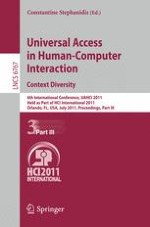The four-volume set LNCS 6765-6768 constitutes the refereed proceedings of the 6th International Conference on Universal Access in Human-Computer Interaction, UAHCI 2011, held as Part of HCI International 2011, in Orlando, FL, USA, in July 2011, jointly with 10 other conferences addressing the latest research and development efforts and highlighting the human aspects of design and use of computing systems. The 47 revised papers included in the third volume were carefully reviewed and selected from numerous submissions. The papers are organized in the following topical sections: universal access in the mobile context; ambient assisted living and smart environments; driving and interaction; interactive technologies in the physical and built environment.
